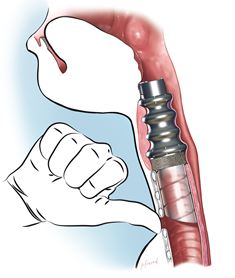First artificial larynx implanted in a human
8 October 2013
Strasbourg University Hospitals has completed the first implantation of an artificial larynx in a human patient. The implant is now the focus of a Europe-wide clinical study and further development before being released for general use.
The artificial larynx has been developed by a team at the University with Strasbourg-based medical device company ProTip SAS.
The procedure started in June 2012 when Professor Christian Debry and his team in the ENT department at Strasbourg University Hospitals carried out the first major surgical procedure on a 65-year-old male with laryngeal cancer.
In this first phase of surgery the surgical team remove the patient's larynx and implanted the first component of the artificial larynx, a tracheal ring made of titanium.
“The main purpose of the tracheal ring that we fitted was to recreate the connection normally formed by the larynx and acting as a kind of funnel between the two,” said Professor Debry. “The material used for the ring means that it can be incorporated into the surrounding tissues, forming an integral part of the throat as a result.”
The second stage in fitting the artificial larynx was completed a few months later, in November 2012. Under general anaesthetic a removable, valve-based device was inserted into the tracheal ring through the patient’s mouth. The artificial larynx device partially replicates the natural functions of the larynx and the patient is again able to breathe through the upper respiratory tract.

Drawing of the
artificial larynx
Twenty years of research
For Professor Debry, this operation marks the culmination of over 20 years of research which began as part of his doctoral thesis while he was still a student. Following years of development work in conjunction with Inserm (Institut national de la sante et de la recherche medicale, France's national institute for health and medical research), with the aim of finding suitable biomaterials for replacing the larynx, Professor Debry's idea finally took shape with the selection of a combination of solid and porous titanium, as biological materials with all the properties needed to create the artificial larynx.
ProTip was founded in 2005 with the aim of accelerating the development of innovative medical devices to treat laryngeal pathologies.
“Laryngectomy is a procedure which has not changed in 140 years,” said Maurice Berenger, CEO of ProTip. “This surgical first paves the way for a procedure which gives new hope to laryngeal cancer patients. Ultimately, it will help patients regain their ability to breathe, speak and eat normally.”
Following the promising initial results achieved in the first patient, ProTip and the Strasbourg University Hospitals will continue to develop the technology and the surgical procedure before making the therapy more widely available. To this end, a Europe-wide clinical study is currently underway.
New hope
Following a total laryngectomy, patients experience a host of difficulties in re-establishing a normal working and family life, specifically because of the tracheostomy,” said Professor Debry. “My primary motivation in developing this artificial larynx is to offer patients an improved quality of life following this type of procedure.
This first operation in Strasbourg is simply the initial feasibility stage. We still have to undertake a number of clinical tests before the larynx implant becomes a routine procedure.”
About laryngeal cancer
In 2008, 150,000 new cases of laryngeal cancer were diagnosed
worldwide, including 28,000 in Europe (source: Cancer Research UK).
Patients who undergo a total laryngectomy lose the ability to
breathe and speak normally. At present, the only option open to
these patients is to undergo a tracheostomy, enabling them to
breathe via a tube placed in their throat, or tracheostoma. In some
very rare cases, a laryngeal transplant has been performed.